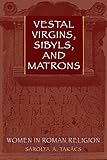Vestal Virgins, Sibyls, and Matrons : Women in Roman Religion / Sarolta A. Takács.
Material type: TextPublisher: Austin : University of Texas Press, [2021]Copyright date: ©2007Description: 1 online resource (220 p.)Content type:
TextPublisher: Austin : University of Texas Press, [2021]Copyright date: ©2007Description: 1 online resource (220 p.)Content type: - 9780292794436
- 292.07082 22
- BL815.W6 T35 2008eb
- online - DeGruyter
| Item type | Current library | Call number | URL | Status | Notes | Barcode | |
|---|---|---|---|---|---|---|---|
 eBook
eBook
|
Biblioteca "Angelicum" Pont. Univ. S.Tommaso d'Aquino Nuvola online | online - DeGruyter (Browse shelf(Opens below)) | Online access | Not for loan (Accesso limitato) | Accesso per gli utenti autorizzati / Access for authorized users | (dgr)9780292794436 |
Frontmatter -- Contents -- List of abbreviations -- Acknowledgments -- Introduction -- One The silent ones speak -- Two Life cycles and time structures -- Three The making of Rome -- Four Rome eternal -- Five Rome besieged -- Six Rome and its provinces -- Conclusion -- Appendix A: Ancient authors -- Appendix B: Timeline -- Appendix C: maps -- Notes -- Bibliography -- Index
restricted access online access with authorization star
http://purl.org/coar/access_right/c_16ec
Roman women were the procreators and nurturers of life, both in the domestic world of the family and in the larger sphere of the state. Although deterred from participating in most aspects of public life, women played an essential role in public religious ceremonies, taking part in rituals designed to ensure the fecundity and success of the agricultural cycle on which Roman society depended. Thus religion is a key area for understanding the contributions of women to Roman society and their importance beyond their homes and families. In this book, Sarolta A. Takács offers a sweeping overview of Roman women's roles and functions in religion and, by extension, in Rome's history and culture from the republic through the empire. She begins with the religious calendar and the various festivals in which women played a significant role. She then examines major female deities and cults, including the Sibyl, Mater Magna, Isis, and the Vestal Virgins, to show how conservative Roman society adopted and integrated Greek culture into its mythic history, artistic expressions, and religion. Takács's discussion of the Bona Dea Festival of 62 BCE and of the Bacchantes, female worshippers of the god Bacchus or Dionysus, reveals how women could also jeopardize Rome's existence by stepping out of their assigned roles. Takács's examination of the provincial female flaminate and the Matres/Matronae demonstrates how women served to bind imperial Rome and its provinces into a cohesive society.
Mode of access: Internet via World Wide Web.
In English.
Description based on online resource; title from PDF title page (publisher's Web site, viewed 26. Apr 2022)


